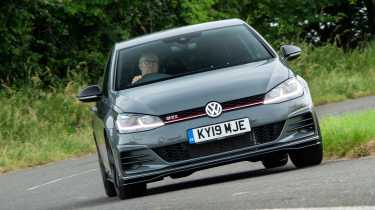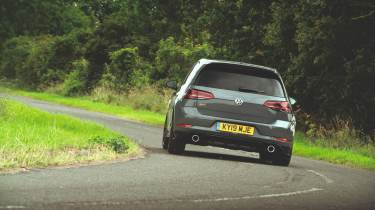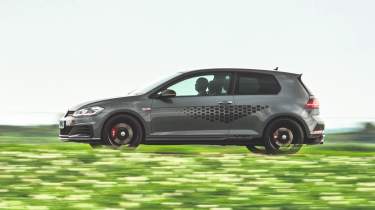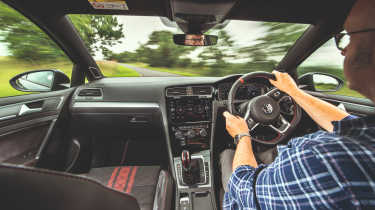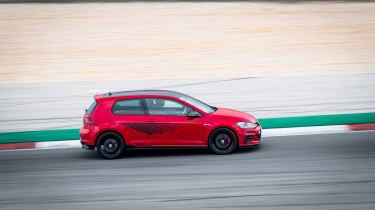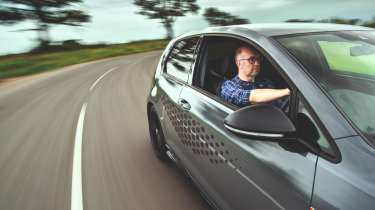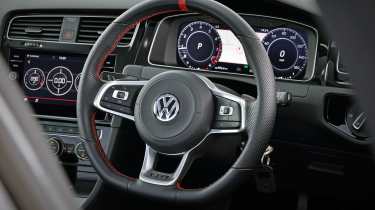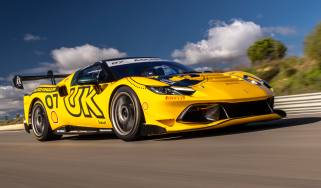Used Volkswagen Golf GTI TCR (2019) review – Mk7’s soft sendoff beats any Mk8
Quick and composed on road or track, the Golf GTI has talents we miss, even if it didn’t sparkle when new
The Mk7 Volkswagen Golf GTI wasn’t long for this world when the GTI TCR (Touring Car Racing) came along, with the final GTIs being short-run specials. As we were driving the Golf GTI TCR, VW was poised to pull the covers off the Mk8 Golf. Anyone else seen ‘Seconds from Disaster’ before?
So the Golf GTI TCR really was a proper sendoff – a GTI Clubsport by another name, designed to draw links to VW’s TCR racing car of the time. While the road car lacked the racer’s wide arches and significant power boost, an eye-catching graphics package did boost the TCR’s visual appeal. It also got the old Clubsport’s impressive engine and dynamics. Though we always regretted that the Golf GTI TCR didn’t push to the heady heights of the phenomenal Golf GTI Clubsport S, with hindsight and knowing what’s come since, it’s a soft sendoff we’re nostalgic for. Especially with used prices from under £20k.
Engine, performance and 0-60 time
The GTI TCR was yet another appearance of VW’s ubiquitous EA888 four-cylinder turbocharged petrol engine, with power and torque figures befitting a car that needed to demonstrate a clear advantage over the conventional GTI but couldn’t step on the Golf R’s toes – even if the chassis was capable of it.
More reviews
In-depth reviews
- Volkswagen Golf GTI 2025 review – the quintessential hot hatch improved but not perfected
- Volkswagen Golf R 2025 review – Mk8.5 not the return to form we'd hoped for
- Used VW Golf GTI (Mk7, 2013 - 2020) review – still the best hot hatch all-rounder
- Volkswagen Golf Mk8.5 2024 review – a return to form for the hatchback benchmark?
Power climbed from the Mk7 GTI Performance’s 242bhp at 5000-6200rpm to 286bhp at 5400-6400rpm, while torque peaked at 280lb ft between 1800 and 5300rpm, compared to 273lb ft from 1600 to 4300rpm. This was sent to the front wheels through an electronically controlled locking diff, and via the sole seven-speed DSG gearbox option.
Performance was strong, with 0-62mph arriving in 5.6sec, and a limited 155mph top speed. Customers could have the car derestricted, but slightly pointlessly, since the maximum increased by just 7mph.
Available in three- and five-door forms, the TCR got a graphics package aping that of VW’s official racing colours and the GTI TCR Concept from the 2018 Wörthersee show, along with a front splitter, rear diffuser element and a spoiler atop the tailgate.
Wheels were 18- inches as standard, but a pair of 19-inch designs were available as part of a Performance package, sitting 20mm lower and removing the top speed restrictor. If you opted for the ‘Pretoria’ wheel design, you also got a set of Cup 2 tyres.
Brake discs and pads were also upgraded on the TCR compared to the regular GTI Performance, and the extra cooling demands of the more powerful engine meant the TCR nabbed the Golf R’s pair of extra radiators, which sat behind the front bumper.
VW Golf GTI Mk7 TCR review
We were somewhat spoiled by hot hatches at the time – quite in contrast to 2025. In 2019 the Golf TCR entered an arena populated by cars as diverse and excellent as the Peugeot 308 GTi, Hyundai i30 N and the Honda Civic Type R.
Dynamically at least, it’s a challenge to which the TCR had little trouble rising. Like its Clubsport predecessor the TCR built impressively upon the standard car, the sharper focus of its underpinnings resulting in a hatch that allows you to deconstruct a twisting road with precision and no shortage of speed.
It’s still a well-balanced car, the TCR, not just in terms of the way grip seems to be shared between the two axles, but in the relationship between the major controls. The steering is a particular highlight. It doesn’t fidget with true road feel but it gets close, giving you a clear picture of what’s happening at ground level and always backed up by a faithful response at the front axle and a convincing increase in weight as you push harder. It’s certainly a step above any Mk8 Golf GTI, from the original standard car to the latest Mk8.5 Golf GTI Clubsport.
Grip isn’t limitless, but drive smoothly – something the TCR encourages with its fluid responses – and you can string together a sequence of bends with real flair. Mid-corner bumps, surface changes and changes in camber are telegraphed, but don’t upset the chassis, and nor does whatever power you choose to send through the front axle. Neither is it an edgy car – allowing you to get away with small mistakes but never feeling inert – while the undoubtedly firm ride never strays into the realms of discomfort.
There’s strong torque from low revs, but power really starts to build in a notable surge between 2500 and 3000rpm and continues to the red line – though the delivery is so linear there’s no great incentive to chase the higher numbers on the dial. You get extra punch low down in Sport mode, but the throttle feels most natural in Normal and you lose nothing in terms of outright performance.
With the DSG ’box you don’t quite get the same interaction you might with a manual, but there’s no doubting its effectiveness. Changes are generally swift and smooth, with occasional delays when calling upon a higher gear if the ’box is expecting you to choose a lower ratio. Nevertheless, perhaps a manual would have been the final distinguishing point to truly cement the TCR as the last high point in Golf GTI lore.
On track, it was impressive too. Portimão could so easily cook a car’s brakes or show weakness in grip and balance, but a GTI TCR on Cup 2s feels rapid and composed. The diff felt particularly effective on track, allowing you to jump on the power surprisingly early without the front end washing wide.
When the TCR first arrived, the Clubsport S was fresh in our memories and talented rivals had proliferated. The TCR lacked a real USP in the 2019 hot hatch landscape, with neither the crushing ability of a Civic Type R or the pure fun factor of an i30 N. If anything, the TCR name drew attention to just how much extra potential could have been unleashed. Today, familiarity with the Mk8 and Mk8.5 Golf GTIs has us remembering the final flavour of fundamental Mk7 ‘rightness’ that was the TCR far more fondly, even if it didn’t punch as hard as it could have.
7300 miles in a VW Golf GTI TCR
‘To try and get under the skin of the final Mk7 VW Golf GTI, we had a GTI TCR to run for seven months and 7300 miles. Here’s how we got on with it:
‘It’s safe to say that it struggled making good first impressions. This was to a small extent because of its black wheels (a pet hate of many on the evo team, myself excluded) but mostly due to the conspicuous graphics plastered down each side of the car. I liked them – indeed, I requested that our car should have this option, as to my mind a hot hatch should stand out as much as possible from the regular model upon which it is based – but I failed to encounter a single other person who had a kind word to say about them.
‘The rest of the TCR’s body addenda – the subtly different splitter, the substantial diffuser, the flared side skirts – had more fans. Not least the lowlifes who attempted to steal said side skirts, presumably to fit to their own Mk7. There was some satisfaction in the would-be thieves being thwarted in their attempt by a neighbour who scared them off mid-removal, but none in the £1016 of damage that had already occurred, and the fact that I now had to park the TCR out of sight for fear of the perps returning. Maybe those attention-grabbing graphics weren’t such a great idea after all.
‘Also under attack was KY19 MJE’s TCR branding. Perhaps the problem wasn’t so much the name itself as what it implied, specifically that the car it was attached to would be some kind of road racer, preferably one in the vein of the ‘did that really happen or did we dream it?’ GTI Clubsport S of 2016. In reality, the TCR was far closer to the lesser Clubsport Edition 40, a car that, in the context of its peers, felt more like it should be the basic, baseline GTI than a special edition. And so it was for the TCR, its 286bhp making it seem competitive rather than putting it at the head of the pack, and its ride taut rather than being racetrack-refugee spec.
‘But the flip side of this was that the TCR made for a great companion for everyday driving, and for long journeys too, as I discovered when taking the TCR up to the Highlands for a week. It was there in particular that it reminded me just how good Golf GTIs are in inclement conditions – reassuring and confidence inspiring at a level that few others can match.’ – Ian Eveleigh, evo 272
VW Golf GTI TCR specs
| Volkswagen Golf GTI TCR | |
| Engine | 1984cc, turbocharged four-cylinder |
| Gearbox | Seven-speed dual-clutch |
| Power | 286bhp @ 5500rpm |
| Torque | 280lb ft @ 1950rpm |
| 0-62mph | 5.6sec |
| Top speed | 155mph |
| Weight | 1430kg |
| Price new | £35,305 |
| Price now | From <£20k |
What to pay and buying guide
At the time, TCR money could have put you in the same ballpark as pre-owned examples of one of the best Golfs ever – the Clubsport S. Needless to say, the older car was the better buy. Today, though, the TCR has depreciated in a manner befitting its less focussed billing, with examples available from around £20k.
It’s worth being aware of consumables on a TCR by comparison to a normal Golf GTI. Upgraded brake discs and pads and Michelin Pilot Sport Cup 2 tyres will cost more to replace. Maybe avoid examples that have had the sticky tyres swapped out for off-brand oddities, as that could indicate corner cutting with maintenance elsewhere. Otherwise, the TCR is GTI and EA888 standard fare – look for good service history and watch out for the thermostat.
Rival options as when new include the aforementioned Hyundai i30 N and Honda Civic Type R. The hot hatches from the east may lack the GTI’s upstanding polish, but they undoubtedly deliver harder-hitting thrills.
